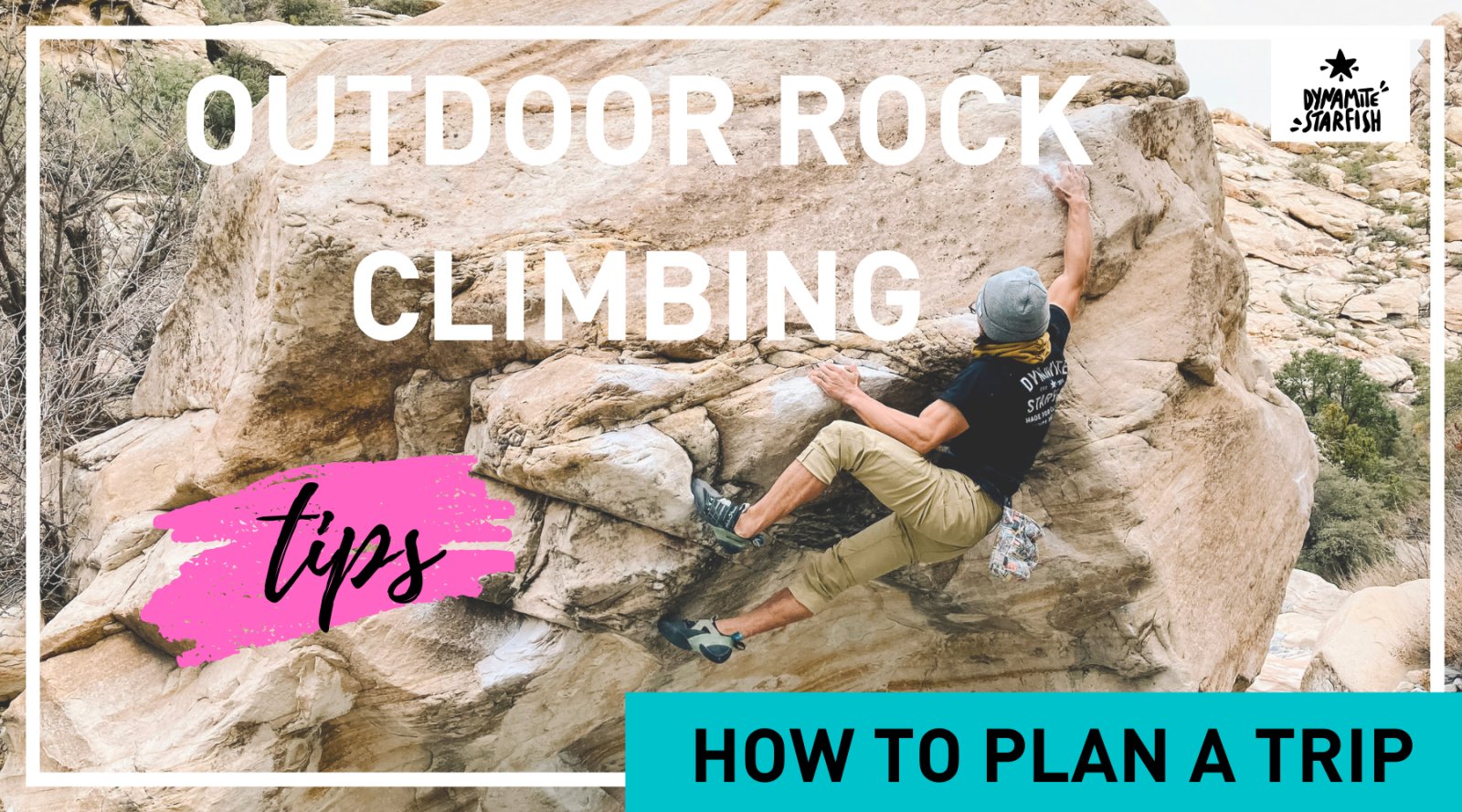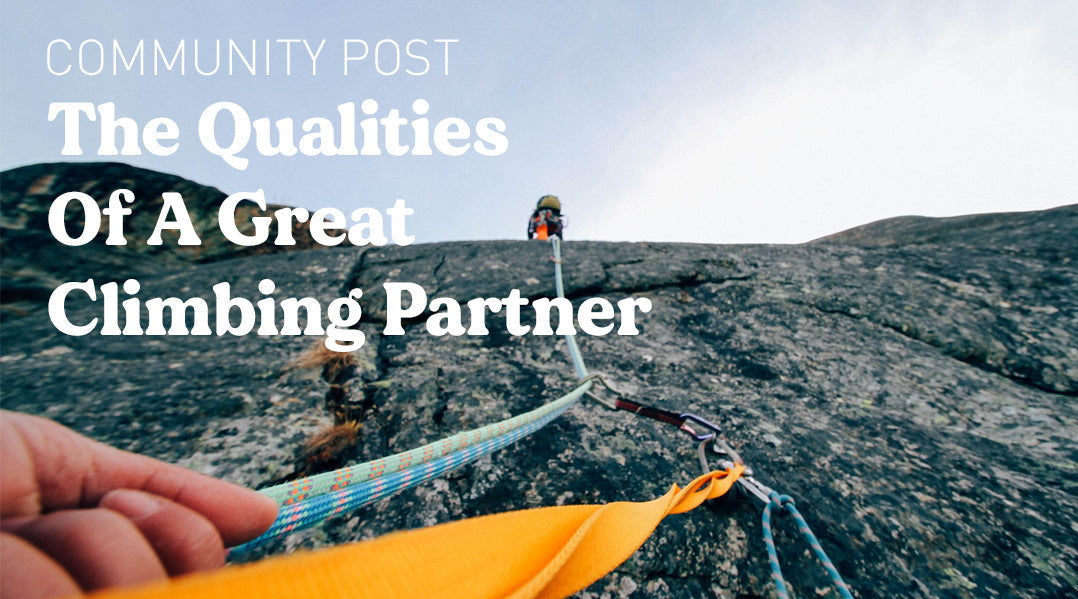Your Cart is Empty
FREE USA SHIPPING ON ORDERS OVER $65!
FREE USA SHIPPING ON ORDERS OVER $65!
How To Plan For An Outdoor Rock Climbing Trip
March 29, 2023 6 min read

Scary, painful, cold, dangerous, & hard — all words we've heard climbers use when talking about outdoor rock climbing. Believe it or not, taking a trip outside doesn't have to be any of these!
Not only is climbing on real rocks one of the most profound experiences our sport has to offer, but it can also be...FUN!
Whether you're a gym crusher who's ready to test your skills outside for the first time or a seasoned veteran looking to plan a multi-day climbing vacation far from home, there are many factors to consider.
But don't worry! We've compiled a list of our top tips on how to plan for an outdoor rock climbing trip so you can get the most out of your next adventure.
Research Where You Want To Go
It might seem intuitive, but spending time researching different climbing areas can have a huge impact on your outdoor experience!
If your location and time allow, we highly recommend starting out at a larger crag that offers a wide variety of styles and difficulty levels. Driving a little further to an area where you sample lots of different climbs is often more satisfying than hang-dogging all over one 5.Hard route at a local spot.
Once you pick a location for your climbing trip, check to see if there's a guidebook. This will make navigating the crag much easier, and proceeds often support the local climbing crew. Mountain Project can be a great source of free information, but be aware that phone batteries and data coverage aren't always what you expect..
(photo courtesy of @lkasmer)
Unlike the climbing gym, you'll need to calculate extra time for the approach hike and actually locating the routes or boulders you want to try. While it's tempting to plan a huge to-do list, unpacking and repacking your gear at each climb is time- consuming! We recommend only having 2 or 3 climbs in mind before you arrive. You can play the rest by ear once you see what motivates your group.
After a day of climbing, you'll need a place to rest and recover if you plan on staying overnight. Campgrounds, like those partnering with the American Alpine Club, are an economical option where you can usually meet fellow climbers. AirBnb or sharing a hotel room could also be a good choice depending on the location. Whichever accommodation you choose, scope out the cancellation policy prior to booking in case the weather turns sour at the last minute.
(photo courtesy of Alex Barlow & Michael Memmel)
Look At The Weather
This goes hand in hand with researching where to go rock climbing!
First, think about the current season and temperatures. On cold winter days, a crag with lots of sunlight and southern-facing rock will be a welcome friend. Similarly, a climbing area with shade is an absolute must on hot summer days.
Sometimes rain spoils the fun, and unfortunately, that's just part of outdoor rock climbing. Some crags have faster drying times than others, but we should always avoid climbing on damp rock to prevent accidentally breaking a hold. Waiting 24 hours after rainfall is a good rule of thumb to help make sure you'll find something dry to climb on.
If you're just starting to venture outside, planning a climbing trip during the fall and spring months is a great way to enjoy comfy temps before experimenting with more extreme weather conditions. Choosing a climbing destination with a variety of sectors or walls will give you playing room to hide in the shade or take in some rays.
Most importantly, keep in mind that the weather in the mountains can change quickly. It's no fun (okay...maybe Type 2 fun) to get caught off guard. When in doubt, always pack clothes for slightly colder weather than you expect!
Need a cozy winter hoodie or boulder beanie? We've got you covered.
(photo courtesy of @marshmoullow)
Plan your crag snacks (and water!)
Your climbing gear is packed, car full of gas, and crew waiting to hit the rocks...but wait! What about the crag snacks?!
When spending long days outdoors, it can be hard to know what food to bring along. We recently shared a guide full of crag snack ideas that will help leave you feeling fueled and ready to crush it on your next rock climbing trip.
In our experience, try sticking to an eating schedule and foods you are already familiar with. Downing stacks of endless IHOP pancakes when you normally eat a light breakfast might not be the greatest idea if you get where we're going...
Getting caught up in the hype of a session and forgetting to eat also happens to the best of us! If it's approaching mealtime and you're too stoked to eat, try taking a bite or two every 15-20 minutes. This helps avoid an energy crash when your body finally decides it's hungry.
(photo courtesy of @jenileevilloso)
Last but not least...water, water, water! Not only do you have to quench your thirst throughout a full day of climbing, but then there's the approach hike and scrambling around the crag to change routes — all without a water fountain. Carrying a little extra water weight sure beats feeling dehydrated at the end of your session. If drinking liquids is a challenge, try taking a few sips after every go. Your body will thank you!
Don't Overdo The Grades
When climbing outside for the first few times, keep in mind that there will be a learning curve since the footholds and handholds won't be marked with bright colors of gym tape.
To help build confidence, warm up with a few extra climbs you feel might be well below your current level. Then slowly up the difficulty with a climb or two until you find something that motivates and challenges you.
(photo courtesy of Sophia Park)
Experienced outdoor climbers often say it takes time to adapt to a new area, so spending the first day doing easier climbs can be a good strategy for success if you're on a longer trip. This also helps avoid completely thrashing your skin on day one — a limiting factor for every climber.
Remember that if you don't 'send' on your first outdoor rock climbing trip...it's perfectly OK! Be proud of yourself for taking on a new challenge and know that your project will be waiting for you when you come back.
Pro Tip: Bring a roll of tape in case your skin feels achy. Taping up or stopping early today = more climbing tomorrow!
(photo courtesy of @megkkee)
Outdoor Ethics
Whole books have been written on this topic, but here are a few quick pointers for when you go rock climbing outdoors:
1. Leave No Trace! - Bring an extra bag to pack out what you bring in. Jaymie Shearer from our DS community did a write-up full of helpful tips and you can read up on these best practices for when nature calls.

(photo courtesy of @kristenliam31 & @trailmothers.la)
2. Check for area-specific rules - Park Rangers, guidebooks, and/or local climber coalitions are your go-to sources of information on parking lots, access to crags, pets, safety issues, & any opening or closing times.
3. Be mindful of chalk - Try to avoid ticking every hold in sight and brush the climb including any marks you may have left when your party is finished. If your chalk bag spills, recover what you can and place the rest in your trash bag to leave the area as clean as possible.
4. Keep dogs on a leash - Be courteous around other climbers until you've asked if they mind a furry friend walking around on their own. Nobody likes getting their only sandwich eaten while they're halfway up a route!
5. Watch noise levels - Many folks come outside to enjoy the sounds of nature, and loud conversations can really put a damper on those who would like to climb in silence. Music is best left for the gym as it can be a BIG safety hazard outdoors along with bothering wildlife and fellow climbers. If you feel it's an absolute must, please ask any nearby parties and keep the volume low.
In general...have fun and be respectful of nature and those around you!

(photo courtesy of @jeffreysburrito)
Going on an outdoor rock climbing trip is an incredibly rewarding experience, and we hope this guide will help you on your next adventure.
If you still have questions about how to go rock climbing outside, don’t worry! Leave us a comment below. We’d love to hear from you.
Until then, happy climbing DS fam!
But WAIT…Don’t forget to complete your crag-fit!
Once you find the perfect spot to go climbing, throw on a comfy top that lets your personality shine. With so many colors and styles, we know you’ll be the coolest climber at the crag.
SHOP OUR UNISEX CLIMBING APPAREL:
1 Response
Leave a comment
Comments will be approved before showing up.
Also in News

The Climbing Training Struggles You Can’t Ignore (And How to Overcome Them)
March 19, 2025 6 min read
Read More
Building Trust and Teamwork: Qualities of a Great Climbing Partner
February 12, 2025 4 min read
Read More Recent Articles
- The Climbing Training Struggles You Can’t Ignore (And How to Overcome Them) March 19, 2025
- Building Trust and Teamwork: Qualities of a Great Climbing Partner February 12, 2025
- Climber Story: Bex Ballow January 29, 2025
- 9 Climbing Resolutions for 2025 December 31, 2024
- Climber Story: Kanani Kalahiki December 11, 2024
- 12 Awesome Gift Ideas for Climbers in 2024 November 20, 2024
- Climber Story: Nick Ranelli November 06, 2024
- If climbing was a scary movie, this would be the title... October 30, 2024
- Climber Story: Britney Berkstresser October 02, 2024
- The best (and worst) names for climbing routes we've ever seen September 25, 2024
Subscribe
Sign up to get the latest on sales, new releases and more …
want 15% off?
Get a welcome gift when you sign up with us!



Jon Krause
March 31, 2023
Great read and epic as always. 🤘
1) maybe bring a small sandwich bag with ibuprofen, antibiotic, antacid/pepto chewables, band aids, elastic wrap, and if needed super glue (deep cut due to sharp rock).
2) go with a buddy first on climbs or area before venturing on your own. If you do go out on your own may consider a global GPS locator with worldwide EMS. I carry Zoleo and it’s only $20/month with Wi-Fi texting.
3) video or pictures are great of not only of the moment while climbing, but geographic landmarks in case you get lost. Don’t night climb without adequate lighting as well as practicing getting to/from climb during day time first.
4) always have fun and make memories.